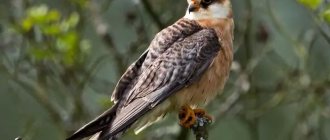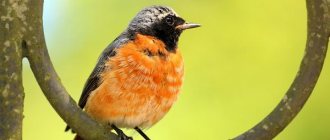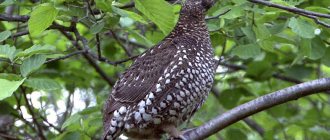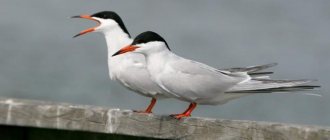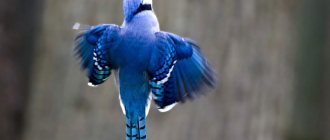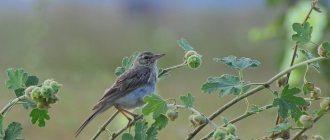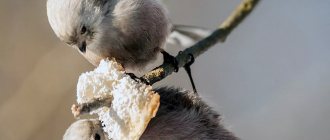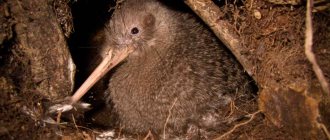- Wild animals
- >>
- Birds
The saker falcon is a large species of falcon. It is a large, strong bird of prey with large legs and pointed wings. It is larger than the peregrine falcon, but slightly smaller than the gyrfalcon and has a very wide wingspan relative to its size. Saker falcons have a wide color range from dark brown to gray and almost white. This is a very graceful falcon that quickly gets used to the company of people and masters hunting skills well. You can learn more about the problems of this amazing species, its lifestyle, habits, and problems of extinction in this publication.
Origin of the species and description
Photo: Saker Falcon
The species has been subject to rampant hybridization and incomplete lineage sorting throughout its existence, making the analysis of DNA sequence data much more difficult. Molecular studies with small sample sizes cannot be expected to demonstrate reliable conclusions across the entire cohort. The radiation of all the living diversity of the ancestors of saker falcons, which took place during the interglacial period at the beginning of the Late Pleistocene, is very difficult.
Video: Saker Falcon
The saker falcon represents a lineage that spread from northeastern Africa deep into southeastern Europe and Asia through the eastern Mediterranean region. In captivity, the Mediterranean falcon and saker falcon can interbreed, and hybridization with the gyrfalcon is also possible. The common name Saker Falcon comes from Arabic and means "falcon".
Interesting fact: The saker falcon is a Hungarian mythological bird and the national bird of Hungary. In 2012, the saker falcon was also chosen as the national bird of Mongolia.
Saker falcons on the northeastern edge of the range in the Altai Mountains are slightly larger, darker, and more visible on the lower parts than other populations. Known as the Altai falcon, they were in the past considered either a separate species of "Falco altaicus" or a hybrid between the saker falcon and the gyrfalcon, but modern research suggests that it is believed to be a form of the saker falcon.
Appearance and features
Photo: What a saker falcon looks like
The saker falcon is slightly smaller than the gyrfalcon. These birds exhibit variations in color and pattern, ranging from a fairly uniform chocolate brown color to a cream or straw base with brown stripes or streaks. Balabans have white or pale spots on the inner tissues of their tail feathers. Because the coloring is usually paler under the wing, it has a translucent appearance when compared to the dark armpits and tips of the feathers.
Female saker falcons are noticeably larger than males and usually weigh from 970 to 1300 g, have an average length of 55 cm, a wingspan of 120 to 130 cm. Males are more compact and weigh from 780 to 1090 g, have an average length of about 45 cm, a wingspan of 100 to 110 cm. The species has subtle “antennae” in the form of dark stripes on the sides of the head. After molting in the second year of life, the wings, back and rump of the bird acquire a dark gray tint. Blue paws take on a yellow tint.
Interesting Fact: The Saker Falcon's features and coloration vary greatly throughout its distribution range. European populations remain in favorable feeding conditions in the breeding area, otherwise they move into the eastern Mediterranean or further south into East Africa.
The wings of the balaban are long, wide and pointed, dark brown above, slightly speckled and striped. The top of the tail is light brown. A characteristic feature is a light, cream-colored head. In Central Europe the species is easily identified from field bird zones, and there is considerable potential for confusion in areas where the Mediterranean falcon (F. biarmicus feldeggi) occurs.
Where does the saker falcon live?
Photo: Saker Falcon in Russia
Saker falcons (often called "saker falcons") are found in semi-desert and forested areas from Eastern Europe to Central Asia, where they are the dominant "desert falcon". Balabans migrate to northern parts of southern Asia and parts of Africa for the winter. Recently, attempts have been noted to breed balabans as far west as Germany. This species occurs in a wide range throughout the Palearctic region from eastern Europe to western China.
They breed in:
- Czech Republic;
- Armenia;
- Macedonia;
- Russia;
- Austria;
- Bulgaria;
- Serbia;
- Iraq;
- Croatia;
- Georgia;
- Hungary;
- Moldova.
Representatives of the species regularly winter or fly to:
- Italy;
- Malta;
- Sudan;
- to Cyprus;
- Israel;
- Egypt;
- Jordan;
- Libya;
- Tunisia;
- Kenya;
- Ethiopia.
In small numbers, stray individuals reach many other countries. The world population remains a subject of study. Saker falcons nest in trees 15-20 meters above the ground, in parkland and in open forests at the edge of the tree line. No one has ever seen a falcon building its own nest. They usually occupy abandoned nests of other bird species, and sometimes even displace their hosts and occupy the nests. In more inaccessible areas of their range, saker falcons are known to use nests on rock ledges.
Nesting
The saker falcon is distinguished by the fact that it never builds nests itself, but only occupies others. As a rule, crows, buzzards and buzzards suffer from Saker raids, but it happens that the saker falcon even invades an eagle’s home. As a rule, the bird tends to settle on rocks and hills. The maximum that a saker falcon can do in a nest is to make “minor repairs” if it is completely dilapidated. To do this, he uses dry branches, bush shoots, skins of killed rodents, fluff, and wool. It is interesting that sometimes the saker falcon occupies several nests at once and lives in them in turn.
What does the balaban eat?
Photo: Saker falcon in flight
Like other falcons, falcons have sharp, curved talons, used primarily for capturing prey. They use their powerful, clawing beak to sever the spine of their prey. During the breeding season, small mammals such as ground squirrels, hamsters, jerboas, gerbils, hares and pikas can make up 60 to 90% of the saker falcon's diet.
In other cases, ground-dwelling birds such as quail, hazel grouse, pheasants and other aerial birds such as ducks, herons and even other birds of prey (owls, kestrels, etc.) can account for 30 to 50% of the total prey, especially in more forested areas. Saker falcons can also eat large lizards.
The main diet of the balaban consists of:
- birds;
- reptiles;
- mammals;
- amphibians;
- insects.
The saker falcon is physically adapted to hunt close to the ground in open areas, combining fast acceleration with high agility and thus specializes in medium-sized rodents. It hunts in open grassy landscapes such as desert region, semi-desert, steppe, agricultural and arid mountainous areas.
In some areas, especially near water and even in urban areas, the falcon switches to birds as its main prey. And in some parts of Europe it preys on pigeons and domestic rodents. The bird stalks prey in open areas, looking out from rocks and trees for prey. The balaban carries out its attack in horizontal flight, and does not fall on the victim from the air, like its other brothers.
Now you know what to feed the saker falcon. Let's see how a falcon lives in the wild.
Nutrition
The saker falcon is a bird of prey. It feeds on small rodents (for example, gophers), as well as hares, pigeons, partridges, ducks, and large lizards. All potential “food” is very afraid of saker falcons. When the prey sees a falcon in the sky, it tends to hide and not come out of its holes. At the same time, saker falcons do not hunt near their own nests, and small mammals readily take advantage of this fact.
The saker falcon looks for prey, as a rule, near water, near rocks or trees, that is, in an area where it is clearly visible. The saker falcon flies towards the victim at high speed, sometimes it can even reach two hundred and fifty kilometers per hour. Having approached the prey, the bird does not slow down. At the same time, the saker falcon does not receive injuries; this is due to its strong skull and joints.
The bird kills its victim with lightning speed and very quietly: falling at a right angle, it hits it hard in the side. As a rule, death occurs instantly. If this does not happen, the saker falcon delivers a second blow, thereby finishing off the victim. The bird absorbs food immediately on the spot or takes it to the nest.
Features of character and lifestyle
Photo: Saker Falcon bird
The Balaban is found in forested steppes, semi-deserts, open grasslands and other arid habitats with scattered trees, rocks or power poles, especially near water. It can be seen perched on a rock or tall tree, where it is easy to survey the surrounding landscape for prey.
The Balaban is a partial migrant. Birds from the northern part of their breeding range migrate widely, but birds belonging to more southern populations lead a sedentary life if there is a sufficient food supply. Birds that winter along the Red Sea coastlines of Saudi Arabia, Sudan and Kenya breed mainly west of the great mountain ranges of Central Asia. Migration of saker falcons occurs mainly from mid-September to November, and the peak of return migration occurs in mid-February - April, the last lagging individuals arriving at the end of May.
Interesting fact: Saker falcon hunting is an extremely popular form of falconry, which is just as exciting as hunting with a hawk. Birds are very attached to their owner, so they are very much valued by hunters.
Saker falcons are not social birds. They prefer not to set up their nests near other nesting pairs. Unfortunately, due to habitat destruction, saker falcons are forced to nest closer together than ever before. In areas with abundant food, saker falcons very often nest relatively close together. The distance between pairs ranges from three to four pairs per 0.5 km² to pairs spaced 10 km or more apart in mountainous areas and steppes. The average interval is one pair every 4-5.5 km.
Bird distribution
— Advertising —
The habitat of the balaban includes the central regions of Asia. Bird species are common in Mongolia, Kazakhstan, Altai, the southern regions of the Krasnoyarsk Territory, the Irkutsk region, Buryatia, and Transbaikalia. Balaban is also found in countries such as Uzbekistan, Turkmenistan, Iran, Afghanistan, and China.
In winter, northern populations of balaban migrate to Ethiopia, the Arabian Peninsula and western China. Southern birds usually lead a sedentary lifestyle.
In all regions of its habitat, the number of balaban is low.
Social structure and reproduction
Photo: Saker Falcon
To attract a mate, males engage in spectacular aerial displays, like many other members of the falcon genus. Male saker falcons soar over their territories, making loud noises. They end their display flights by landing near a suitable nesting site. During closer encounters with a partner or prospective partner, saker falcons bow to each other.
Males often feed females during the nesting period. While courting a potential mate, the male will fly around with prey hanging from his talons, or bring it to the female in an attempt to show that he is a good food provider. There are from 2 to 6 eggs in a brood, but usually their number is from 3 to 5. After the third egg is laid, incubation begins, which lasts from 32 to 36 days. In general, as with most falcons, the offspring of boys develop faster than those of girls.
Interesting fact: The young chicks are covered in down and are born with their eyes closed, but they open them after a few days. They have two molts before they reach adult plumage. This happens when they are just over a year old.
Females reach sexual maturity about a year before males. The chicks begin to fly at 45 to 50 days of age, but remain in the nesting territory for another 30 to 45 days, and sometimes longer. If there is a large localized food source, the offspring may stay together for a while.
While in the nest, chicks chirp to attract the attention of their parents if they are isolated, cold or hungry. In addition, females may make a soft "breaking" noise to encourage their young to open their beaks for food. When the brood is well fed, the chicks get along better than in a brood with a lack of food. In a well-fed brood, the chicks share food and also explore each other once they begin to fly. On the contrary, when food is scarce, chicks guard their food from each other and may even try to steal food from their parents.
Natural enemies of balaban
Photo: Saker Falcon in winter
Saker falcons have no known predators in the wild other than humans. These birds are very aggressive. One of the reasons they are so prized by falconers is that once they decide to choose a prey, they become very persistent. The balaban follows its prey relentlessly even in the thickets.
In the past they were used to attack large game such as gazelle. The bird chased the victim until it killed the animal. Saker falcons are patient, relentless hunters. They hover in the air or sit on their perch for hours, watching for prey and recording the exact location of their target. Females are almost always dominant over males. Sometimes they try to steal prey from each other.
This species suffers from:
- electric shock on power lines;
- reduction in the availability of production due to the loss and degradation of steppes and dry pastures as a result of the intensification of agriculture and the creation of plantations;
- a decrease in the level of sheep breeding, and as a result a decrease in populations of small birds;
- trapping for falconry, which causes local extinction of populations;
- use of pesticides leading to secondary poisoning.
The number of saker falcons caught annually is 6,825 to 8,400 birds. Of these, the vast majority (77%) are juvenile females, followed by 19% adult females, 3% juvenile males and 1% adult males, potentially creating a severe bias in the wild population.
Hunting with falcons
Falconry originated about 4 thousand years ago, its historical roots lead to Mesopotamia (present-day Iraq, Kuwait, Syria), China and Mongolia. This activity has always been the lot of the nobility, an indicator of wealth and high status. Today, the art of hunting with birds of prey is maintained mainly as a tribute to a beautiful tradition. The exception is falconry for bustards (large birds that live mainly in the steppe and semi-desert regions of Eurasia), which today is a favorite pastime of wealthy Arab sheikhs.
What does this have to do with bustards? It all started with the fact that these birds discovered a way to quickly get rid of endoparasites, which is a vital necessity for them. During mating season, male bustards slowly walk in front of the females, lowering their wings to the ground and raising their tail vertically. And their potential girlfriends, instead of admiring their beauty from the front, come from the rear and carefully study the snow-white feathers in the cloaca area. If the latter have traces of excrement or blood, which may indicate infection with parasites, then such a “contender” for the hand and heart is immediately rejected.
As a remedy for helminths (and, accordingly, to increase reproductive success), bustards use ... beetles from the blister family (Meloidae). On contact, blister bugs release a toxic substance called cantharidin.
, which, when ingested in large quantities, causes poisoning and even death in pasture animals.
However, when “taking” it in small doses, intestinal parasites are the first to suffer. During the mating season, male bustards eat beetles especially readily, especially since these birds managed to develop a certain resistance to cantharidin (Bravo et al
., 2014). So during mating, bustard meat is literally saturated with this substance.
People have long shown interest in blisters, but as an aphrodisiac: powder from dried blisters was credited with the ability to increase male potency. But bustard meat caught during the mating period turned out to be preferable to dried beetles. Due to the lack of firearms at that time, birds of prey began to be actively used to catch the desired prey. However, before the era of technological progress, a balance was maintained between people, bustards and falcons. In addition, falconers adhered to certain traditions and taboos that did not allow them to cause significant harm to bird populations.
This all changed in the 1970s, when the Gulf countries experienced an oil boom, generating strong economic growth. In the Arab world, falcon hunting received a new flourishing, becoming an even more elite activity. Modern falconry for bustards, as well as the capture of the feathered predators themselves, is carried out with the participation of private aviation and high-speed cars, this has endangered birds from anywhere in the world. And ancient traditions were transformed into rituals that lost their original meaning.
At the same time, it was the saker falcon - a versatile, hardy feathered predator with a variety of attack tactics - that began to be in great demand compared to other large falcons. the gyrfalcon, which lives mainly in the Arctic Circle
does not tolerate the hot and dry climate of Arab countries, and its immunity, formed in the sterile conditions of the Arctic, cannot cope with the abundance of pathogenic agents characteristic of the arid zone.
The peregrine falcon, the fastest bird in the world, is inferior to the saker falcon in a variety of hunting tactics; In addition, this falcon specializes in hunting in the air, while the bustard either runs on the ground or flies very low. Lanner
and
laggar
are smaller in size than saker falcons, and, like the peregrine falcon, they are not such universal hunters, which is why they are valued lower. As a result, human pressure on the saker falcon populations became so powerful that they could not resist.
Population and species status
Photo: What a saker falcon looks like
Analysis of available data has led to a global population estimate of 17,400 - 28,800 breeding pairs, with the largest numbers in China (3,000-7,000 pairs), Kazakhstan (4,808-5,628 pairs), Mongolia (2,792-6,980 pairs) and Russia (5,700- 7300 pairs). The small European population is estimated at 350-500 pairs, equivalent to 710-990 mature individuals. The population in Europe and probably Mongolia is currently increasing, but the overall demographic trend is estimated to be negative.
Assuming a generation lasts 6.4 years and the species had already begun to decline (at least in some areas) before the 1990s, the overall population trend over the 19-year period 1993-2012 corresponds to a 47% decline (according to average estimates) with a minimum-maximum reduction of 2-75% per year. Given the significant uncertainty in the abundance estimates used, preliminary estimates suggest the species is declining by at least 50% within three generations.
Interesting fact: Saker falcons, due to their large size, are preferred by falconers, which leads to a gender imbalance among wild populations. In fact, about 90 percent of the nearly 2,000 falcons trapped each year during the fall migration are females.
These numbers are controversial because some saker falcons are illegally caught and trafficked, making it impossible to know the true number of saker falcons taken from the wild each year. Chicks are easier to train, so most captured saker falcons are about a year old. Additionally, many falconers release their pets because they are difficult to care for during the hot summer months and many trained birds run away.


